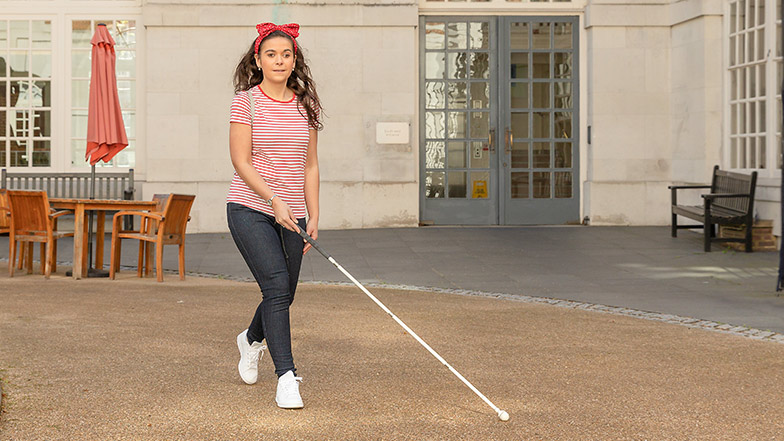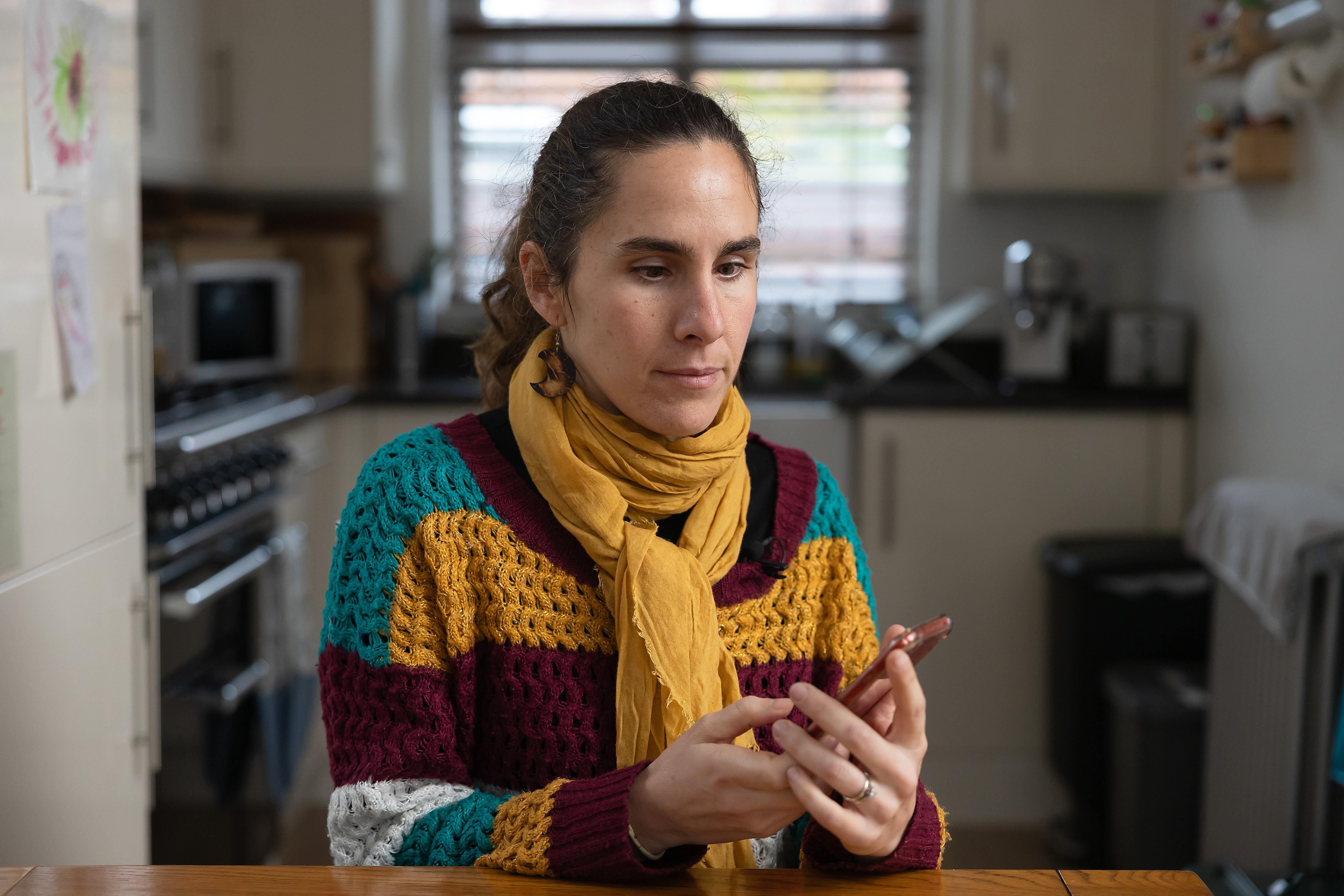Clew app
The Clew app supports people who are visually impaired with indoor navigation. This can be helpful when you’re navigating unfamiliar places, for example walking from your seat to the bathroom in a café, or retracing your steps from a meeting room to the exit. It’s used to help you navigate back from somewhere you’ve already walked, rather than helping you get to a new destination without sighted assistance (if you’re looking for help getting around outside or on your own, have a look at our guides on Be My Eyes).
Clew uses augmented reality (AR) and doesn’t require GPS signal or access to mobile data or wi-fi. It uses sounds, haptic feedback, and directional audio cues to guide you to where you want to go.
The app is only available on iPhone and provides guidance in English, Arabic and Spanish.
On this page
How does the Clew app work?
The Clew app uses your phone’s rear camera to record a route. Start recording at the place you’d like to return to, then walk the route one way. The app will work out how to guide you back to the place you started using directional audio cues and visual prompts on your phone’s screen.
Before you record a route, you need to choose whether you’d like to map a Single Use route or a Saved route - one you’re likely to use more than once.
The Single Use route option is helpful if you have sighted assistance one way, but you’ll have to retrace your steps independently. The Save route option is ideal for journeys you’ll have to make a lot, like navigating between areas of your school or office. You may still find a sighted assistant is useful for recording and saving the route the first time around.
- Single Use Route: This option allows you to record a route one way and then retrace your steps. After you’ve finished recording the first part of the route, the app will ask you if you’d like to make the return journey straight away or pause and make the return journey later. The route won’t be saved within the app after you’ve completed the route.
- Save Route: To save a route for re-use, you’ll need to create an anchor point (the place you’ll start and finish your route) at the start, so the app knows where to start the navigation when you access the route in the future. You’ll then record the route one way and Clew will save it. Once you’ve finished the outbound route, the app will ask you to name the route, and it’ll appear in your Saved Routes List in future.
- Saved Routes List: Scroll through your list of previously recorded routes and choose the route you’d like to walk. The app will ask if you’d like to walk it from start to end or end to start. Select the one you need and head to the route’s anchor point. There’ll be an alignment process, where Clew will ensure you’re in the right place to start the navigation. Once you’re in the right place, the navigation will start automatically.
How Clew can help you
Clew is designed to support and enhance indoor navigation, rather than replace your core orientation and mobility skills. However, it can help as a supplemental tool to help you navigate your environment.
- Single Use Route - This can be useful if you have sighted assistance, for example from your seat in a café to the toilet, allowing you to return to your seat independently. Another great use could be tracing your steps back from a hospital clinic to the exit, as often people are guided by a member of staff one way only. You could also use this function at places like the train station or at an airport for navigating while you wait - but just bear in mind that security teams may ask you about why you’re recording.
- Save Routes – This mode is best for routes you are doing often where you may want to go back to the guidance again. For example, getting places within your local gym, university campus or large office – you might want to record your route to the canteen for lunch, meeting rooms or anywhere you need to go often. This is especially helpful if you work across different sites and need a reminder of where things are in this particular location.
Things to keep in mind when using the Clew app
- Clew is designed to support and enhance indoor navigation, not to replace your core mobility skills. It can’t recognise obstacles or changes on a route, so always remain aware of your surroundings and use Clew as a supplemental tool.
- If using headphones, suitable open-ear headphones are ideal.
- The device used should be held steady at chest height in portrait orientation with the screen facing towards the user. You’ll get feedback if your phone is not upright.
- You only need to record a route one way – the reverse will be done by the app.
- Bear in mind the privacy of others when recording routes in public places.
- As well as providing audio cues, your phone will vibrate when you’ve reached the end of sections of your route.
- You should use permanent features, like a doorway, when marking an anchor point.
- If you want to save a route, you must select “Save Route” before recording your journey – you can’t record a Single Use route then decide you’d like to save it.
- You don’t need to create an account to use the Clew app.
- It’s currently only available on Apple devices.
How to download Clew
![]()
If you have an iPhone, you can download Clew for free from the App Store. The app’s icon features a light green background, with a ball of yarn centred within a
white location pin in the middle.
Apps that are similar to Clew
- Be My Eyes: Be My Eyes connects you to friends, family and a network of sighted volunteers, who can help you identify your surroundings. The app also uses artificial intelligence to help with tasks like describing what’s around you.
- Seeing AI: Seeing AI uses artificial intelligence to describe objects around you. Its World channel can help with indoor navigation and locating objects.
- Google Lens: Google Lens enables picture-based searches. The app can identify items and objects in your surroundings and read aloud signage.
You might also like...
Looking for recommendations on products and apps that can help you with your daily activities?
Edited and reviewed by Vision Rehabilitation Specialist Beata Lisowska on 21/08/2024
Guide Dogs is committed to integrating technology into our service delivery and promoting excellence in accessibility and usability. Our staff undergo comprehensive training in technology and accessibility in collaboration with industry leaders like Apple. We foster knowledge of technology and create content through our Technology Champions, comprising Vision Rehabilitation Specialists and Habilitation Specialists. We review this content periodically to ensure that it is up to date and includes new features and changes with operating systems. We work with our partners to ensure accessibility is at the centre of the design. To find out more, there is more information in our accessibility policy.
Please note: Whilst Guide Dogs may be able to suggest various third-party websites and third-party applications which may be able to assist you, those are not endorsed by Guide Dogs. Guide Dogs have no control over those third parties and cannot be held responsible for the accuracy of information and support they can provide or the suitability and quality of any products or services they provide.



